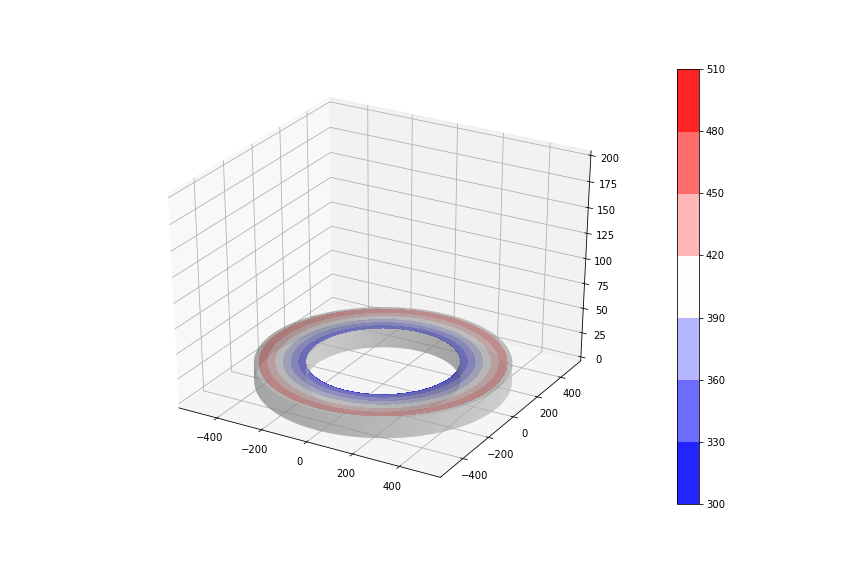I have a 3D plot of a disk. Now I would like to plot the surface in color depending on values which are stored in an array. E.g. the radius of the disk is 300mm. The array could like:
arr = np.array([[ 114.28, 14],
[ 128.57, 16],
[ 142.85,19],
[ 157.13,20],
[ 171.41,21],
[ 185.69,22],
[ 199.97,24],
[ 214.25,27],
[ 228.53,29],
[ 242.81,30],
[ 257.09,31],
[ 271.37,34],
[ 288.65,35],
[ 299.93,36],
[ 300,38]])
It means for radius = 114.28 I have the value 14. I would like to plot a circle at radius 114.28 in a color (e.g. blue). Second radius is 128.57. For the radius 128.57 the value 16 is assigned. That means I would like to plot a circle in another color e.g. orange on the surface of the plot and so on.
I tried to solve this problem with contourplot (thanks to bazingaa). It looks exactly as I want it to. Unfortunately I just realized that this is not really the solution to my problem. Maybe I should explain what I'm trying to achieve. I want to show how certain parameters, such as speed, are distributed along the disc. In this case the contourplot would also correct, as the speed increases towards the outside. But it can also happen that parameters have to be visualized which do not always increase towards the outside continuously. I tried this scenario and simply made a value in the middle of the array smaller than the value before it (I changed the value 27 to 14 from arr) and nothing happens in the contourplot except that the legend changes. Maybe contourplot is not the right approach after all? Maybe I have to draw individual circles and assign colors to them and interpolate between the circles to fill the gaps.

import numpy as np
import matplotlib as mlp
import matplotlib.pyplot as plt
import mpl_toolkits.mplot3d.axes3d as axes3d
ri = 100
ra = 300
h=20
# input xy coordinates
xy = np.array([[ri,0],[ra,0],[ra,h],[ri,h],[ri,0]])
# radial component is x values of input
r = xy[:,0]
# angular component is one revolution of 30 steps
phi = np.linspace(0, 2*np.pi, 2000)
# create grid
R,Phi = np.meshgrid(r,phi)
# transform to cartesian coordinates
X = R*np.cos(Phi)
Y = R*np.sin(Phi)
# Z values are y values, repeated 30 times
Z = np.tile(xy[:,1],len(Y)).reshape(Y.shape)
fig = plt.figure()
ax = fig.add_subplot(1, 1, 1, projection='3d')
ax.set_zlim(0,200)
ax.plot_surface(X, Y, Z, alpha=0.5, color='lightgrey', rstride=1, cstride=1)
plt.contourf(X, Y, np.sqrt(X ** 2 + Y ** 2), zdir='z', offset=20,
cmap=plt.cm.rainbow)
cbar = plt.colorbar()
arr = np.array([[ 114.28, 14],
[ 128.57, 16],
[ 142.85,19],
[ 157.13,20],
[ 171.41,21],
[ 185.69,22],
[ 199.97,24],
[ 214.25,27],
[ 228.53,29],
[ 242.81,30],
[ 257.09,31],
[ 271.37,34],
[ 288.65,35],
[ 299.93,36],
[ 300,38]])
cbar.ax.set_yticklabels(arr[:,1])
plt.show()
I hope someone can help, it is very important to me. Best regards !

